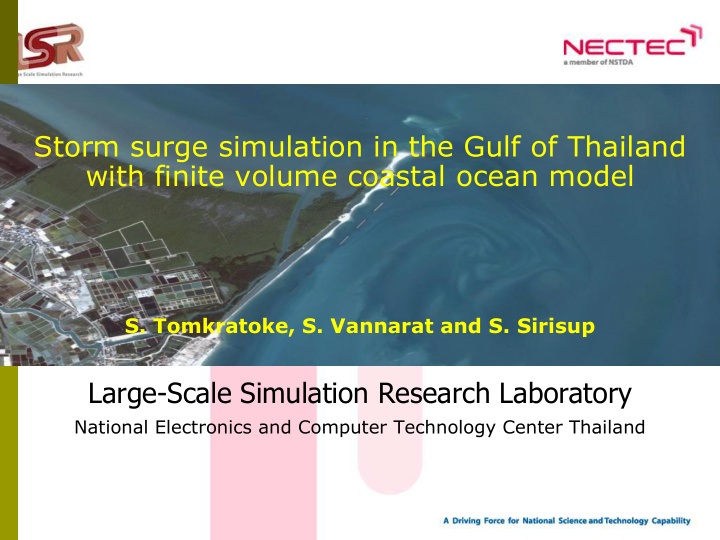



Storm surge simulation in the Gulf of Thailand with finite volume coastal ocean model S. Tomkratoke, S. Vannarat and S. Sirisup Large-Scale Simulation Research Laboratory National Electronics and Computer Technology Center Thailand
Outline Introduction and motivation The gulf of Thailand (GOT) Current and future situations Methods and related data FVCOM/data TC wind model Results Tide Storm tide Surge mechanism Conclusions
Coastline and the gulf of Thailand The Gulf of Thailand covers 320,000 square km. (514,000) The length of the coastline of Thailand is approximately 2,637 km. (4,863) 12 millions people (66) reside near or long the coastline. (within 10 meters height of the coast plains) Coastal businesses (tourism and coastal, estuary fishery) have generated more than US$7 Bn annually (150Bn) 3 Google Map
Storm surges and coastal floods Statistically, there have been a few storm systems that created storm surges in Thailand. Recently are Harriot (1962), Gay(1989), Linda (1997) Typhoon Gay (1989) 4 http://www.digital-typhoon.org
Effects of climate change ? The changing climate can alter storm patterns: Storm frequency Storm intensity Storm paths Mean sea-level rise There is also increasing intensive land and sea use along the river-coast continuum for tourism as well. Adding it up all together with the fact that the Thai gulf is relatively shallow, the consequences can be intensified To address this, we will perform the scenario-based simulation studies. 5
Tools: Ocean Hydrodynamic model The keys for obtaining an accurate prediction Geographical data include: A good physical coastal Observations of oceanography model with Special modules accurate wet/dry treatment the current states capability. High resolution of bathymetry and topography data as well as Solve Governing equations model ability to handle complex and realistic geometry. Accurate wind and pressure data to drive the model FVCOM as our coastal simulator FVCOM is a prognostic, unstructured-grid, finite-volume, free-surface, 3-D primitive Final Results equation coastal ocean circulation model developed by UMASSD-WHOI joint efforts. The 6 project is led by Prof. Changsheng Chen http://fvcom.smast. u massd.edu/FVCOM
Tools: Tropical cyclones model The Typhoon Linda, 1997(10/31-11/4) Best Track (digital typhoon) Provides Location Wind Speed Pressure We will only use Holland Wind model: surface stresses in this study. 7 J.Phaksopa,“Storm surge in the gulf of Thailand generated by Typhoon Linda in 1997 using Princeton Ocean Model(POM),” Chulalongkorn university, 2003.
Tools: Related data Geographical data Shoreline (NOAA) Bathymetry (GEBCO) ENC data (Hydrographic dept) Physical validation/forcing data Best track from Digital typhoon Data from tide gauges (for validation: Marine Dept and Hydrographic service dept) OTIS tide information 8
Results: Tidal Gauges validation Now, we force open BC with 13 constituents (all possible constituents from OTIS) The comparison is done by comparing FVCOM results to the reconstruction of 13 constituents from the observation data We use observation data from year 1997, whole year from the Hydrographic dept, Royal Thai navy and Marine dept. 9
Results: Tidal Gauges validation Comparison to tide gauges for major constituents Amplitude error : < 0.03 meters Phase error : < 30 degree 1 : Guohong Fang et al., Continental Shelf Research 19 845-869,1999 2 : TETSUO YANAGI and TOSHIYUKI, Journal of Oceanography, Vol. 54, 143-150.1998 3 Qingwen M., Yiquan Q., Ping S., Haigang Z., Zijun G. Chinese Science Bulletin ,2006 , 51 Supp. II ,26-30 4 : Egbert G. D. and S. Y. Erofeeva, Journal of Atmospheric and Oceanic Technology , 2002, 19 (2), 183-204
Results: Amphidromic system & Tidal range in the GOT O 1 K 1 M 2 S 2
Tropical cyclone model: Typhoon Linda 3-Nov-97: 18UTC 2-Nov-97: 00UTC 3-Nov-97: 06UTC
Simulation Results 2-Nov-97: 05UTC 3-Nov-97: 08UTC
Results: Storm tide validation Koh Lak Water level (m) Hours since 00:00 29/10/1997 ___ Calculation (storm included) Observed --- Tide (calculated)
Results: Storm Tide validation Koh Matapon Koh Lak Koh Prap Laem Singh
Results: Surge mechanism • Negative surge Koh Lak • Decrease ~0.8-1.0 m from normal tide 350 km from Surat Thani province Storm wave dominated Weak current
Results: Surge mechanism • Depressing tide Koh Lak • Decrease ~0.8-1.0 m from normal tide ~180 km from Chum Porn Depressing high tide Circular flow dominated
Results: Surge mechanism • Positive surge Koh Lak • Increase ~ 0.5 m from normal tide After Land fall 11 hr Amplifying high tide Remaining flow & Strong tidal wave
Conclusions and outlook Conclusions • The current model is able to capture the negative surge very well, however we still need improvements especially for the positive surge prediction near the estuary . • The interaction process between the storm surge wave and tidal wave can induces the negative surge along the GOT coast • The circular flow induced by the tropical storm Linda sweeps the water away from the GOT coast causing the depressing tide • Influence of the remaining flow induced by the TC Linda together with the strong tidal wave can induce the positive surge in the GOT Outlook • Consider coastal flood inundation • Consider effect of tropical cyclone path and shelf geometry
Recommend
More recommend